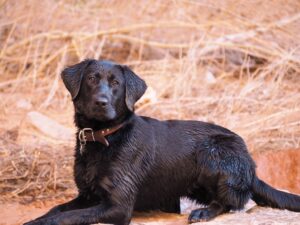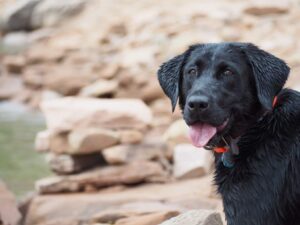Station training, also known as place training, is a highly functional behavior that we can use to “place” a dog in a specific location for a period of time. Station training is a slightly more advanced skill that can take some time to truly master, but it is useful in a wide variety of situations.
The components of station training are relatively simple, and can be broken down into three aspects:
- Send your dog to their station
- Automatically laying down on their station when they arrive
- Proofing the behavior
Supplies: your dog, a cot/mat/bed/target/towel, lots of high value treats, leash (optional)
Teaching the Down
Before we teach our dog to go to their station, we are going to teach them to lay down on their station. Starting in this order makes the next step so much easier! (This is a process called backchaining!)
- Place your dog’s mat on the ground with plenty of space around it and behind it. Stand or sit at one end of the mat. You’ll be placing treats directly on it, so plan accordingly!
- Lure your dog onto their mat and reward them. You can also toss a treat away from you, then call them so they walk onto their mat as they return. If your dog knows “Down!” you can cue that at this time.
- In 1-2 second intervals, place 5-10 treats one at a time on their mat, on the end closest to you. Place each treat in the same spot.
- If your dog is not yet laying down, you can lure them into a down.
- Continue placing treats on their mat in the same spot for 30 seconds or so.
- When you’re done rewarding them, say “Get it!” then toss a treat away from their bed.
Repeat this a few times before proceeding to the next step. You know you’re ready to teach the send when your dog automatically gets on their mat and lays down when you stand next to it.
Teaching the Send
- Place your dog’s mat on the ground with plenty of space around it and behind it. Stand at one end of the mat.
- Lure your dog onto the mat into their normal down position and reward them a few times. Say “Get it!” and toss a cookie away from the bed.
- After your dog eats the cookie, lure them back onto the mat. Repeat this a few times, until they are headed to the mat on their own without needing a lure.
- Say “Get it!” and toss a treat. After they eat it, say “Place!” before they head back to their spot. Reward them as normal.
- Next, start adding variety to the direction of approach. Repeat the sequence of “Place!” ⇨ (support with lure as needed) ⇨ dog goes to bed and lays down ⇨ reward ⇨ “Get it!” ⇨ Toss cookie with the following variations. Repeat each variation until they don’t need much help to be successful.
- Toss the cookie behind you and cue them from there.
- Toss the cookie to the side and cue them from there.
- Stand to the side of their bed. Reward them in the original location, so they’re not facing directly at you.
- Stand 1ft away from their bed.
- Turn away from the bed after you cue them.
- Stand 3ft away from their bed.
- Stand 5ft away from their bed.
- Standing 3ft away from their bed, say “Get it!” and drop the cookie next to you. Then cue them back to their bed.
- Continue along this pattern, adding distance.
Proofing
Proofing this behavior is where the function comes in! Decide where you want this behavior to function, and proof it to that standard. Asking for your dog to station at Disneyland is a much bigger task than the same behavior in your living room. Check out our article on proofing for more information.



